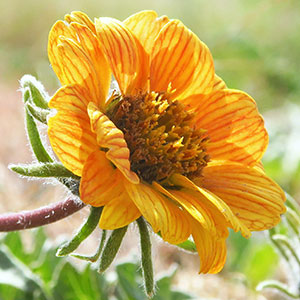Balsamorhiza hispidula
Balsamorhiza rosea
hairy balsamroot, hispid balsamroot
rosy balsamroot
blades bright green, narrowly lance-elliptic to lanceolate, (6–)15–25(–40) × (3–)5–9+ cm (1–2-pinnatifid, primary lobes lanceolate to oblanceolate, 10–45 × 2–15 mm, secondary lobes usually divergent, antrorse), bases ± cuneate, ultimate margins usually entire (± revolute and/or thickened, often ciliate), apices acute to attenuate, faces ± hispidulous to hirtellous (gland-dotted as well; veins ± scabrous).
blades gray-green, oblong to lance-ovate, 3–10(–20) × 2–5 cm (rarely pinnately lobed), bases weakly cordate or truncate, margins crenate to serrate, apices rounded to acute, faces finely strigose to moderately scabrous (usually gland-dotted as well).
campanulate to hemispheric 10–25 mm diam.
hemispheric, 18–20 mm diam.
15–40 mm (abaxially glabrous).
(becoming brick-red, often drying to pink or rose, and chartaceous) (8–)15(–25) mm (hispidulous abaxially; cypselae strigose).
lanceolate to linear, 12–20 mm, not surpassing inner, apices acute to attenuate (margins often ciliate).
deltate or ovate to lanceolate, 8–12 mm, not surpassing inner.
borne singly.
usually borne singly.
= 38.
Balsamorhiza hispidula
Balsamorhiza rosea
Distribution of Balsamorhiza hispidula is highly disrupted in the southern part of its range.
(Discussion copyrighted by Flora of North America; reprinted with permission.)
In a hybrid swarm involving Balsamorhiza rosea and B. careyana, B. rosea remains relatively uncontaminated; the dominance among the hybrids appears to lie with B. careyana. A record of a hybrid between B. rosea and B. careyana from the Spokane area is doubtful.
(Discussion copyrighted by Flora of North America; reprinted with permission.)


